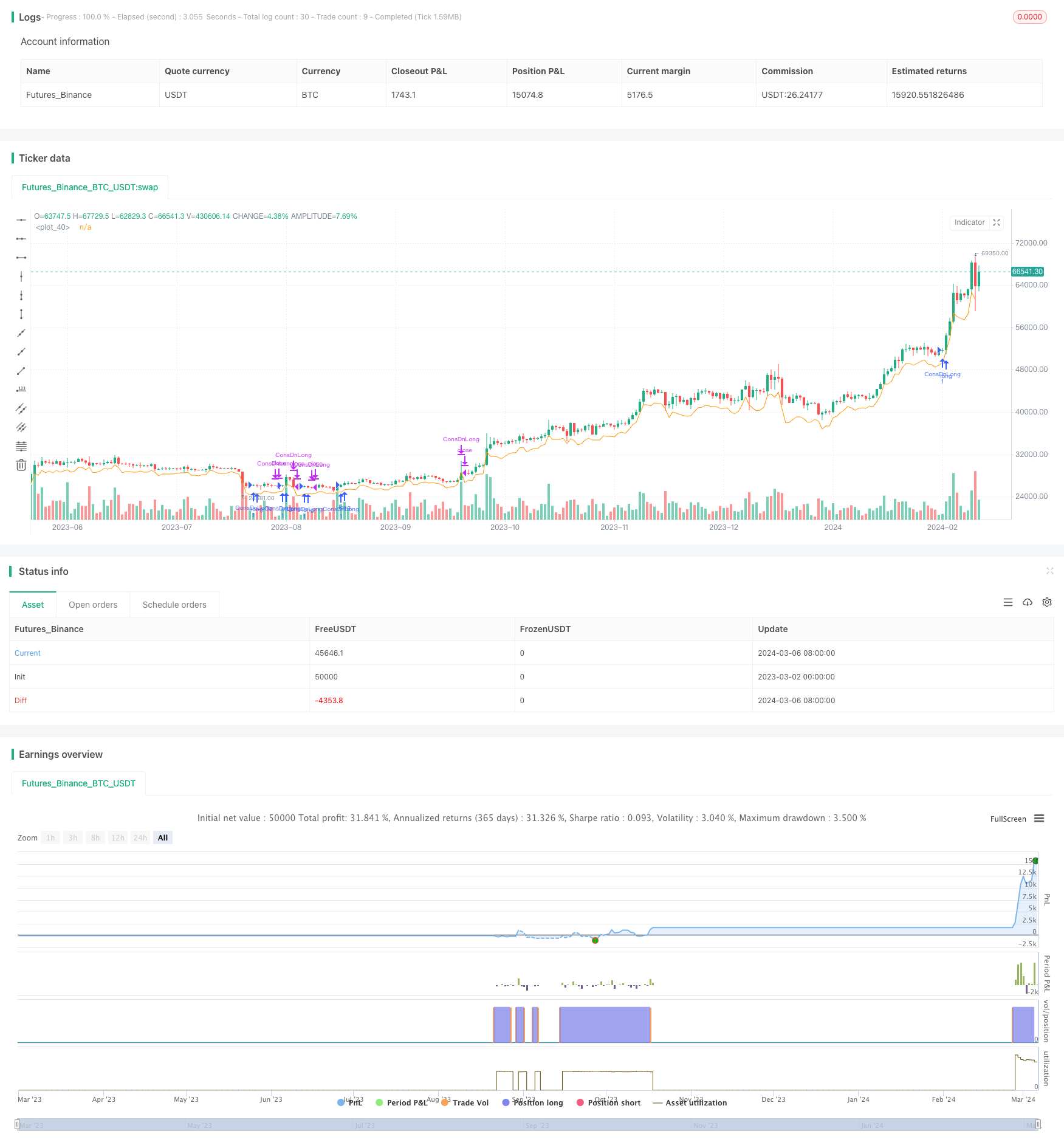
概述
连续阴跌-阳涨反转策略是一种基于价格阴跌和阳涨连续性的量化交易策略。该策略通过识别连续X根阴线跌破最低点,随后连续Y根阳线上涨的形态,来捕捉短期趋势反转机会。策略的主要思想是,当价格经历连续的阴跌后,表明空头动能已经释放,随后如果出现连续的阳涨,则意味着多头力量开始积聚,价格可能迎来一波反弹行情。因此,该策略试图抓住这种由空头转多头的价格反转机会,从而获取利润。
策略原理
连续阴跌-阳涨反转策略的原理可以分为以下几个步骤:
- 参数设置:设置连续阴跌根数(consecutiveBarsDown)和连续阳涨根数(consecutiveBarsUp)。
- 判断市场趋势:统计当前价格连续阴跌(dns)和连续阳涨(ups)的根数。
- 入场条件:当满足以下条件时开仓做多:
- 当前交易时间在回测区间内(date())
- 前两根K线连续阴跌达到consecutiveBarsDown设定值
- 当前K线连续阳涨达到consecutiveBarsUp设定值
- 当前没有持仓(not active)
- 设置止损:开仓后,将止损价格(stop_loss)设置为最近三根K线收盘价的最低点。
- 出场条件:当满足以下条件时平仓:
- 当前交易时间在回测区间内(date())
- 当前有持仓(active)
- 收盘价低于止损价(close < stop_loss)或者低于最高价减去2倍ATR(close < high - 2 * atr(7))
- 复位变量:平仓后,重置变量active为false,entry_bar_index为一个很大的值。
该策略利用连续阴跌和阳涨的形态,试图捕捉由空头向多头转变的反转机会。同时,设置了严格的止损条件,以控制风险。
优势分析
连续阴跌-阳涨反转策略具有以下优势:
- 趋势敏感性:通过统计连续阴跌和阳涨的根数,策略对价格趋势的变化较为敏感,能够快速识别潜在的反转机会。
- 形态简单明了:该策略基于简单的连续阴跌和阳涨形态,规则清晰,易于理解和实现。
- 止损严格:策略在开仓时设置了相对严格的止损条件(最近三根K线收盘价的最低点),能够在趋势无法延续时及时出场,控制损失。
- 参数可调:连续阴跌和阳涨的根数可以根据市场特点和交易品种进行调整,增加了策略的灵活性。
风险分析
尽管连续阴跌-阳涨反转策略有一些优势,但仍存在以下风险:
- 频繁交易:当市场波动较大时,价格可能会频繁触发策略的入场和出场条件,导致交易次数增加,手续费成本上升。
- 止损位置:策略的止损位置是最近三根K线收盘价的最低点,这可能会导致止损位置过于靠近入场价,从而在正常的市场波动中触发止损,造成不必要的损失。
- 趋势延续风险:该策略主要捕捉反转机会,但当市场趋势强烈持续时,反转形态可能失效,导致策略出现连续亏损。
为了应对这些风险,可以考虑以下优化措施: - 根据市场波动特点,动态调整连续阴跌和阳涨的根数要求,减少频繁交易。 - 优化止损位置的设置方式,如使用ATR或者百分比止损,给予价格更多的波动空间。 - 在趋势强烈持续的市场环境下,考虑减少交易或者逆向交易,避免逆势操作。
优化方向
连续阴跌-阳涨反转策略还有以下几个可以优化的方向:
- 引入更多指标:除了连续阴跌和阳涨的根数外,可以结合其他技术指标如RSI、MACD等,以提高入场和出场信号的准确性。通过多指标共同确认,可以减少伪信号,提高策略的盈利能力。
- 优化止损和止盈:目前策略使用的是固定的止损位置(最近三根K线收盘价的最低点),可以考虑使用动态止损或者移动止损的方法,如ATR止损或者跟踪止损。同时,可以加入止盈条件,如目标利润达到一定比例时平仓,以锁定已有利润。
- 适应不同市场环境:该策略在震荡市场中表现可能更好,而在趋势市场中可能面临风险。可以考虑根据市场环境的变化,动态调整策略参数或者停止交易,以适应不同的市场状态。
- 加入仓位管理:目前策略是全仓操作,可以引入仓位管理的概念,根据市场风险和个人风险承受能力,调整每次交易的仓位大小,以控制整体风险。
- 结合其他策略:连续阴跌-阳涨反转策略可以与其他策略相结合,如趋势跟踪策略、均值回归策略等,形成策略组合,提高整体收益的稳定性。
通过以上优化措施,连续阴跌-阳涨反转策略可以更好地适应市场变化,控制风险,提高盈利能力和稳定性。
总结
连续阴跌-阳涨反转策略是一种基于价格连续性的量化交易策略,通过识别连续阴跌和阳涨的形态,捕捉市场短期反转机会。该策略规则简单明了,对价格趋势的变化较为敏感,且设有严格的止损条件以控制风险。同时,策略参数可以根据市场特点进行调整,增加了灵活性。
然而,该策略也存在一些风险,如频繁交易、止损位置设置可能过于严格、以及在强趋势市场中表现可能欠佳等。为了应对这些风险,可以考虑动态调整参数、优化止损位置、在不同市场环境下采取不同策略等措施。
此外,该策略还有一些优化的方向,如引入更多指标、优化止损和止盈、适应不同市场环境、加入仓位管理以及与其他策略相结合等。通过不断优化和改进,连续阴跌-阳涨反转策略可以成为一个更加稳健和有效的量化交易策略。
总的来说,连续阴跌-阳涨反转策略提供了一种简单而有效的交易思路,通过捕捉市场短期反转机会来获取利润。但在实际应用中,需要结合具体市场环境和个人风险偏好,对策略进行适当的优化和调整,以达到更好的交易效果。
/*backtest
start: 2023-03-02 00:00:00
end: 2024-03-07 00:00:00
period: 1d
basePeriod: 1h
exchanges: [{"eid":"Futures_Binance","currency":"BTC_USDT"}]
*/
//@version=5
strategy("Bottom Out Strategy", overlay=true)
consecutiveBarsUp = input(2)
consecutiveBarsDown = input(3)
price = close
ups = 0.0
ups := price > price[1] ? nz(ups[1]) + 1 : 0
dns = 0.0
dns := price < price[1] ? nz(dns[1]) + 1 : 0
var entry_bar_index = 1000000
var active = false
var stop_loss = 0.0
// === INPUT BACKTEST RANGE ===
i_from = input(defval = timestamp("01 Jan 2023 00:00 +0000"), title = "From")
i_thru = input(defval = timestamp("01 Mar 2024 00:00 +0000"), title = "Thru")
// === FUNCTION EXAMPLE ===
date() => true
entry_condition() =>
date() and dns[2] >= consecutiveBarsDown and ups >= consecutiveBarsUp and not active
exit_condition() =>
date() and active and (close < nz(stop_loss) or close < high - 2 * ta.atr(7))
if (entry_condition())
strategy.entry("ConsDnLong", strategy.long, comment="CDLEntry")
entry_bar_index := bar_index
active := true
stop_loss := math.min(close, close[1], close[2])
// log.info("Entry at bar {0}, close={1}, stop_loss={2} ", entry_bar_index, close, stop_loss)
if (exit_condition())
strategy.close("ConsDnLong", comment = "CDLClose")
// log.info("Close at bar {0}", bar_index)
entry_bar_index := 1000000
active := false
// if (dns >= consecutiveBarsDown)
// strategy.entry("ConsDnSE", strategy.short, comment="ConsDnSE")
//plot(strategy.equity, title="equity", color=color.red, linewidth=2, style=plot.style_areabr)
plot(high - 2* ta.atr(7))